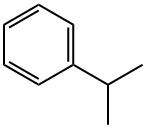Cumene hydroperoxide , ≥80% , 80-15-9
Synonym(s):
α,α-Dimethylbenzyl hydroperoxide
CAS NO.:80-15-9
Empirical Formula: C9H12O2
Molecular Weight: 152.19
MDL number: MFCD00002129
EINECS: 201-254-7
PRODUCT Properties
| Melting point: | -30 °C |
| Boiling point: | 100-101 °C/8 mmHg (lit.) |
| Density | 1.03 g/mL at 25 °C |
| vapor density | 5.4 (vs air) |
| vapor pressure | <0.03 mm Hg ( 20 °C) |
| refractive index | n |
| Flash point: | 192 °C |
| storage temp. | 2-8°C |
| solubility | Chloroform (Soluble), Ethyl Acetate (Slightly), Methanol (Soluble) |
| form | clear liquid |
| pka | pK1:12.60 (25°C) |
| color | Colorless to Almost colorless |
| PH | >5 (20°C, 13g/L in H2O) |
| Water Solubility | Slightly soluble |
| BRN | 1908117 |
| Exposure limits | No exposure limit is set. On the basis of its
irritant properties, a ceiling limit of 2 mg/m3
(0.3 ppm) is recommended. |
| Stability: | Stable. combustible. Strong oxidizer. Incompatible with a variety of organic materials, reacting vigorously or violently with acids, reducing agents, many metals, strong alkalies. Heat sensitive, decomposing explosively. |
| LogP | 1.6 at 25℃ |
| CAS DataBase Reference | 80-15-9(CAS DataBase Reference) |
| NIST Chemistry Reference | Hydroperoxide, 1-methyl-1-phenylethyl(80-15-9) |
| EPA Substance Registry System | Cumene hydroperoxide (80-15-9) |
Description and Uses
Cumene hydroperoxide, an organic peroxide,is a colorless to pale yellow to green liquid. Mild odor.Molecular weight=152.21; Boiling point=153℃;Freezing/Melting point=2 10℃. It explodes on heating;Flash point=79℃. Its explosive limits are: LEL=0.9%;UEL=6.5%. Hazard Identification (based on NFPA-704 MRating System): Health 1, Flammability 2, Reactivity 4(Oxidizer). Slightly soluble in water.
Cumene hydroperoxide is used in the preparation of polystyrene nanocapsules. It acts as a curing agent for polyester resins and as an oxidizer in organic chemical reactions. It serves as an initiator for radical polymerization especially for acrylate and methacrylate monomers. It also employed as an intermediate in the cumene process for developing phenol and acetone from benzene and propene. Further, it is used as an epoxidation reagent for allylic alcohols and fatty acid esters. In addition to this, it is also used to prepare methylstyrene, acetophenone and cumyl alcohol.
Safety
| Symbol(GHS) |      GHS02,GHS05,GHS06,GHS08,GHS09 |
| Signal word | Danger |
| Hazard statements | H242-H302+H312-H304-H314-H331-H335-H373-H411 |
| Precautionary statements | P210-P280-P301+P330+P331-P303+P361+P353-P304+P340+P310-P305+P351+P338-P370+P378 |
| Hazard Codes | O,T,N |
| Risk Statements | 7-21/22-23-34-48/20/22-51/53-66-65-10-37 |
| Safety Statements | 14-3/7-36/37/39-45-50-61-14A-26-62-47-7 |
| RIDADR | UN 3109 5.2 |
| WGK Germany | 3 |
| RTECS | MX2450000 |
| TSCA | TSCA listed |
| HazardClass | 5.2 |
| PackingGroup | II |
| HS Code | 29096000 |
| Hazardous Substances Data | 80-15-9(Hazardous Substances Data) |


